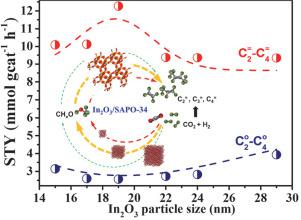Chinese Journal of Catalysis ( IF 15.7 ) Pub Date : 2021-08-30 , DOI: 10.1016/s1872-2067(21)63851-2 Siyu Lu 1, 2 , Haiyan Yang 1 , Zixuan Zhou 1, 2 , Liangshu Zhong 1, 2, 3 , Shenggang Li 1, 2, 3 , Peng Gao 1, 2 , Yuhan Sun 1, 3, 4

|
A reaction-coupling strategy is often employed for CO2 hydrogenation to produce fuels and chemicals using oxide/zeolite bifunctional catalysts. Because the oxide components are responsible for CO2 activation, understanding the structural effects of these oxides is crucial, however, these effects still remain unclear. In this study, we combined In2O3, with varying particle sizes, and SAPO-34 as bifunctional catalysts for CO2 hydrogenation. The CO2 conversion and selectivity of the lower olefins increased as the average In2O3 crystallite size decreased from 29 to 19 nm; this trend mainly due to the increasing number of oxygen vacancies responsible for CO2 and H2 activation. However, In2O3 particles smaller than 19 nm are more prone to sintering than those with other sizes. The results suggest that 19 nm is the optimal size of In2O3 for CO2 hydrogenation to lower olefins and that the oxide particle size is crucial for designing catalysts with high activity, high selectivity, and high stability.
中文翻译:

In2O3 粒径对双功能催化剂上 CO2 加氢制低级烯烃的影响
反应偶联策略通常用于 CO 2加氢,以使用氧化物/沸石双功能催化剂生产燃料和化学品。由于氧化物组分负责 CO 2活化,因此了解这些氧化物的结构效应至关重要,但是,这些效应仍不清楚。在这项研究中,我们将不同粒径的In 2 O 3和 SAPO-34 作为双功能催化剂用于 CO 2加氢。低级烯烃的CO 2转化率和选择性随平均In 2 O 3 的增加而增加微晶尺寸从 29 nm 减小到 19 nm;这种趋势主要是由于导致 CO 2和 H 2活化的氧空位数量不断增加。然而,小于19nm的In 2 O 3颗粒比其他尺寸的颗粒更容易烧结。结果表明,19 nm 是用于 CO 2加氢生成低级烯烃的 In 2 O 3的最佳粒径,并且氧化物粒径对于设计具有高活性、高选择性和高稳定性的催化剂至关重要。











































 京公网安备 11010802027423号
京公网安备 11010802027423号